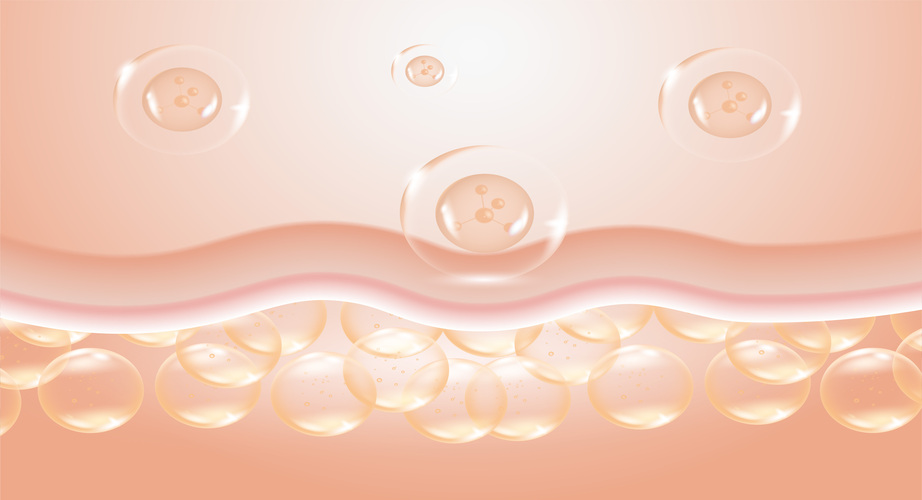What are the types of collagen? Types of collagen and its functions

Collagen is the most important structural protein in the human body, responsible for skin firmness, joint flexibility, and bone strength. Although its production naturally declines with age, proper supplementation can help maintain tissue health. Learn how collagen is structured, its types and sources, and which type to choose for yourself.
Table of contents
- Collagen Structure - what is its structure like?
- What are the types of collagen?
- What is a collagen type?
- Fibrous collagens and their functions
- What are non-fibrous collagens and what functions do they perform?
- The most common collagen types in the human body
- Types of collagen based on their source
- Forms of collagen
- Collagen supplementation - choose the best type of collagen for you
Collagen Structure - what is its structure like?
Collagen is one of the most common proteins found in the human body. It is the main component of connective tissue and is also present in structures such as the skin, articular cartilage, bones, muscles, and blood vessels. The primary function of collagen is to maintain the integrity of tissues and organs.
Collagen is not only an essential building block of musculoskeletal tissue, but it also participates in wound healing and repair processes – it is constantly synthesized and broken down in the extracellular space. Additionally, it facilitates the better absorption of nutrients, increasing bone density and ensuring proper resistance to injuries.
What are the types of collagen?
Collagen refers to a group of structural proteins commonly found in the human body. Collagen is made up of about 30% glycine. It also contains amino acids such as proline, alanine, and hydroxyproline.
Less commonly found in collagen fibers are lysine and its derivative – hydroxylysine. An inseparable component of collagen is water, which determines both its structure and biological activity.
Due to the origin of collagen, it is classified into:
- fish collagen
- beef collagen
- pork collagen
- poultry collagen
The main source of collagen is animal-derived products, so animal tissues are primarily used to obtain this valuable protein, which is used, among other things, in supplement production. Good sources of collagen are both pig bones and tendons, as well as fish skin.
What is a collagen type?
To understand exactly how collagen works, one must be aware that there are many types. At least 29 types of collagen exist, and each is made up of amino acids and performs slightly different functions in the human body.
What types of collagen are found in the human body? Below we briefly describe the most important ones.
Fibrous collagens and their functions
The family of structural proteins can be divided into two basic groups: fibrous collagens and non-fibrous collagens. The scientific community is primarily interested in fibrous collagens, which were the first to be discovered (hence they are often referred to as classical collagens). These include the following collagen types: I, II, III, V, XI, XXIV, and XXVII.
Fibrous collagens have a structure of three spirally wound polypeptide chains containing fragments made up of amino acid residues. Interestingly, most collagen fibers in this family exhibit heterotypy, meaning they are made up of more than one type of collagen.
Type I collagen
The most well-known type of collagen in the fibrous collagen family is type I collagen. It is the most common in the body, found in bones, tendons, muscle fibers, skin, and the cornea of the eye. This type of collagen is primarily responsible for tissue resistance to stretching in the tissues where it is present.
Type II collagen
Type II collagen makes up as much as 90% of articular cartilage. It is also present in the vitreous body, the optic nerve membrane, and other native human tissues. Besides protecting bones from injury and cushioning shocks, it provides tissues with appropriate flexibility, durability, and resistance to friction.
Type III collagen
Type III collagen is a key component of the dermis, lung tissues, liver, spleen, and blood vessels. The aggregation of their fibers provides tissues with the right elasticity and flexibility. Type III collagen often complements type I collagen, especially in tissues requiring elasticity.
Type IV collagen
Type IV collagen is considered one of the key components of the basement membrane, the extracellular matrix responsible for holding cells together. Type IV collagen can be found in muscle fibers, epithelium, endothelium, nerve cells, and fat tissue.
Types V and XI collagen
Types V and XI collagen are primarily heterotrimers, formed from three different chains. They are found mainly in the skin, bones, cornea, cartilage, and intervertebral discs.
Type X collagen
Type X collagen, which is made up of short amino acid chains, plays a crucial role in the mineralization of the cartilage matrix. Its role is to transform cartilage tissue into hard bone tissue. Additionally, it supports natural regenerative processes after bone injuries and fractures.
What are non-fibrous collagens and what functions do they perform?
In addition to fibrous collagens, there are non-fibrous collagens. They are known for not forming typical fibrils. Despite their significant variety, they constitute only 10% of the collagen mass in the animal body. Non-fibrous collagens include types IX, X, XII, XIV, XVI, XIX, XX, XXI, and XXII. There is still relatively little known about them, as research on these types of collagen is still in its early stages.
Non-fibrous collagens can be divided into several main groups. These include:
- basement membrane collagen (type IV)
- anchoring collagen (type VII)
- collagen forming microfibers (types VI, XXVIII, XXIX)
- collagen forming hexagonal network structures (types VIII, X)
- collagen containing transmembrane MACIT domains (types XIII, XVII, XXIII, XXV)
- collagen belonging to the FACIT family (types IX, XII, XIV, XVI, XIX, XX, XXI, XXII, XXVI)
- multiplexing collagens (types XV, XVIII)
Non-fibrous collagens are located in various parts of the human body. They are found, for instance, in nerve cells, fat tissue, the brain, heart, kidneys, lungs, liver, and spleen. They can function both on the surface of cells as receptors and as soluble extracellular molecules.
Best collagen
The most common collagen types in the human body
Collagen is one of the most important and complex structural proteins in the human body. It is mainly found in the skin, joints, bones, skeletal muscles, and blood vessels.
With age, due to the progressive aging processes of the body, collagen production decreases. After the age of 25, fibroblasts produce less collagen, and collagen fibers become shorter and weaker. A deficiency of this protein in the body can manifest as wrinkles on the skin, joint pain and stiffness, brittle hair and nails, as well as longer recovery times after exercise.
Due to the reduced collagen production in the body, many people turn to collagen supplements. To choose a product suitable for their body's needs, it's important to know which types of collagen protein are present in the human body.
Collagen’s polymorphism means that 29 genetically different types of this compound can be distinguished in human tissues.
Collagen types found in joints
The primary building block of articular cartilage is type II collagen. It is responsible for maintaining the musculoskeletal system in good condition and also determines its elasticity and strength during movement.
Type II collagen is primarily found in the matrix of articular cartilage, bone, and intervertebral discs. With age, due to reduced collagen production, the hydration of the cartilage matrix decreases, leading to joint problems, such as pain, stiffness, and limited mobility.
Collagen types in the skin
The dominant form of collagen in the skin is type I collagen. It is found in both the dermis and subcutaneous tissue. Additionally, up to 15% of the collagen protein in our skin consists of type III collagen, which is responsible for the proper arrangement of collagen fibers and the skin's elasticity. Type III collagen predominates in the skin of newborns and in tissue forming scars.
Additionally, trace amounts of types V, VI, VII, VIII, XII, XIII, XIV, XVI, XIX, and XXIX collagen are found in the human skin.
Types of collagen based on their source
Based on the source of extraction, four main types of collagen are distinguished: fish (marine) collagen, beef (bovine) collagen, pork collagen, and poultry collagen. Collagen types should not be confused with collagen protein sources.
The most important types of collagen based on their source of origin:
Fish collagen
It is mainly obtained from the bones, skins, and scales of fish such as salmon, pollock, Atlantic cod, and tuna. It contains natural collagen peptides and amino acids that are well absorbed in the human digestive system. Fish collagen, also known as marine collagen, is rich in type I collagen, which is present in human bones, muscles, tendons, and articular cartilage. Its production is more efficient and less costly than, for example, beef collagen.
Beef collagen
It is obtained from bovine connective tissue, such as tendons, bones, and skin. It primarily contains types I and III collagen, which are found in human bones, muscles, and blood vessels. Beef collagen has no characteristic fish taste or odor. Supplements based on this type of collagen are a good alternative to fish-based collagen products and are often recommended to people with sensitivity to marine-derived proteins.
Pork collagen
It is derived from the bones, tendons, and skin of pigs. Pork collagen is primarily rich in type I collagen and, to a lesser extent, type III collagen. Its advantage is very good biocompatibility, but its use may carry a higher risk of allergic reactions than fish collagen.
Poultry collagen
It is obtained from the cartilage, skin, feet, and bones of poultry. It primarily contains type II collagen, which constitutes a significant portion of collagen fibers in the human body.
Poultryn hydrolysates are extremely versatile and can provide support for the health of the skin, joints, and many other tissues.
Other types of collagen used in dietary supplements and cosmetics include:
Native collagen
This protein features an original, three-dimensional structure similar to that of human collagen; thanks to maintaining its natural structure, native collagen is more biocompatible with our skin than other types of collagen – for this reason, this form of protein is often found in face creams and gels.
Microcollagen
These are small protein fragments that are often used in aesthetic medicine to slow down the processes of skin aging. Collagen in this form interacts with the epidermis in a way very similar to natural collagen – for this reason, it is commonly used in aesthetic medicine as a filler to smooth the skin surface in areas of wrinkles and atrophic scars.
Tropocollagen
This is the smallest subunit that forms collagen fibers, consisting of glucose and galactose molecules, as well as four amino acids (proline, glycine, lysine, and hydroxyproline). It has the shape of a triple helix and serves as a precursor to mature collagen in the human body.
Atelocollagen
This is highly purified collagen stripped of some telopeptides, characterized by high bioavailability and minimal immunogenicity; this makes the use of atelocollagen safe for the immune response.
In addition to collagen, dietary supplements and cosmetics aimed at skin care with visible signs of aging often contain additional active ingredients. The most frequently used ones include vitamin C and hyaluronic acid. These compounds stimulate collagen production, so maintaining their proper levels in the body is crucial for preserving skin elasticity and the proper functioning of the musculoskeletal system. Additionally, vitamin C is an exceptionally strong antioxidant and neutralizes free radicals responsible for premature aging.
Ingredients that increase the bioavailability of collagen include chondroitin sulfate, glucosamine sulfate, and coenzyme Q10.

Collagen supplementation - choose the best type of collagen for you
As time passes, collagen synthesis decreases, and the body loses its ability to rebuild collagen fibers. Disruptions in the production of this protein begin as early as the age of twenty-five. As a result, cartilage wears down, skin elasticity decreases, and wrinkles, stretch marks, and cellulite appear.
To prevent these problems, many people choose to use dietary supplements containing collagen and its hydrolysates. The recommended daily dose of this protein may vary depending on the type of product used, lifestyle, physical activity, and individual predispositions.
When searching for high-quality collagen supplements, it’s worth checking out the offerings from the brand OstroVit. Supplements from this Polish manufacturer, based on hydrolyzed marine or bovine collagen, can be an excellent way to supplement this valuable protein in the body.
The collagen offered by OstroVit stands out due to its pure, natural composition and does not contain synthetic preservatives, dyes, or unnecessary fillers. It is also regularly tested in independent, accredited laboratories and holds all the certificates required by European law. In addition to collagen in tablet form, the manufacturer offers collagen powder that dissolves easily in water, making it easy to mix with drinks or food.
A great solution for consumers who are looking for comprehensive support for their body may also be the complex products that, in addition to collagen, contain hyaluronic acid, vitamin C, or glucosamine.

